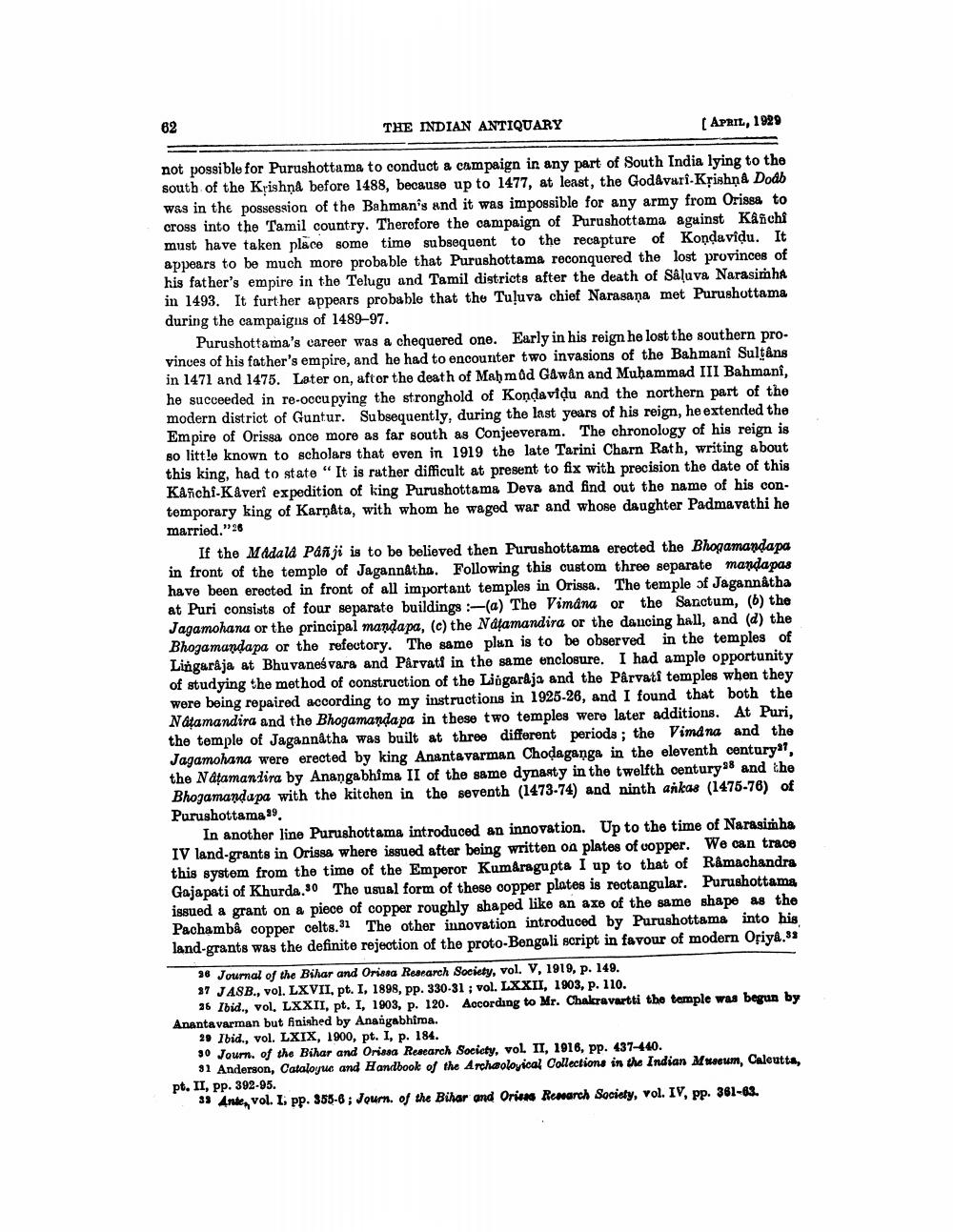________________
THE INDIAN ANTIQUARY
APRIL, 1929
not possible for Purushottama to conduct a campaign in any part of South India lying to the south of the Křishna before 1488, because up to 1477, at least, the Godavari-Kțishna Doab was in the possession of the Bahman's and it was impossible for any army from Orissa to cross into the Tamil country. Therefore the campaign of Purushottama against Käfichi must have taken place some time subsequent to the recapture of Kondavidu. It appears to be much more probable that Purushottama reconquered the lost provinces of his father's empire in the Telugu and Tamil districts after the death of Saluva Narasimha in 1493. It further appears probable that the Tuļuva chief Narasaņa met Purushottama during the campaigns of 1489-97.
Purushottama's career was a chequered one. Early in his reign he lost the southern provinces of his father's empire, and he had to encounter two invasions of the Bahmani Sultans in 1471 and 1475. Later on, aftor the death of Mahmad Gawan and Muhammad III Bahmani, he succeeded in re-occupying the stronghold of Kondavidu and the northern part of the modern district of Guntur. Subsequently, during the last years of his reign, he extended the Empire of Orissa once more as far south as Conjeeveram. The chronology of his reign is so little known to scholars that even in 1919 the late Tarini Charn Rath, writing about this king, had to state“ It is rather difficult at present to fix with precision the date of this Kanchi-Käveri expedition of king Purushottama Deva and find out the name of his contemporary king of Karnata, with whom he waged war and whose daughter Padmavathi he married."26
If the Madala Panji is to be believed then Purushottama erected the Bhogamanda pa in front of the temple of Jagannatha. Following this custom three separate manda pas have been erected in front of all important temples in Orissa. The temple of Jagannâtha at Puri consists of four separate buildings (a) The Vimana or the Sanctum, (b) the Jagamohana or the principal manda pa, (c) the Nafamandira or the dancing hall, and (d) the Bhogamandapa or the refectory. The same plan is to be observed in the temples of Lingaraja at Bhuvanes vara and Pârvati in the same enclosure. I had ample opportunity of studying the method of construction of the Lingaraja and the Parvati temples when they were being repaired according to my instructions in 1925-26, and I found that both the Natamandira and the Bhogamanda pa in these two temples were later additions. At Puri, the temple of Jagannatha was built at three different periods; the Vimana and the Jagamohana were erected by king Anantavarman Chodaganga in the eleventh century, the Natamandira by Anangabhima II of the same dynasty in the twelfth century S8 and the Bhogamandapa with the kitchen in the seventh (1473-74) and ninth ankas (1475-76) of Purushottama'.
In another line Purushottama introduced an innovation. Up to the time of Narasimha IV land-grants in Orissa where issued after being written on plates of copper. We can trace this system from the time of the Emperor KumAragupta I up to that of Ramachandra Gajapati of Khurda.30 The usual form of these copper plates is rectangular. Purushottama issued a grant on a piece of copper roughly shaped like an axe of the same shape as the Pachambê copper celts.31 The other innovation introduced by Purushottama into his land-grants was the definite rejection of the proto-Bengali script in favour of modern Osiya.59
20 Journal of the Bihar and Orissa Research Society, vol. V, 1919, p. 149. 37 JASB., vol. LXVII, pt. I, 1898, pp. 330-31 ; vol. LXXII, 1903, p. 110.
26 Ibid., vol. LXXII, pt. I, 1903, p. 120. According to Mr. Chakravartti the temple was begun by Anantavarman but finished by Anangabhima.
29 Ibid., vol. LXIX, 1900, pt. I, p. 184. 30 Jour of the Bihar and Orissa Research Sociсty. vol. II, 1916, pp. 437–440.
31 Anderson, Cataloyuc and Handbook of the Archeoloyical Collections in the Indian Museum, Caleutta, pt. II, pp. 392-95.
13 Ante, vol. I, pp. 366-8; Journ. of the Bihar and Orines Renarch Society, Vol. IV, pp. 361-63.




